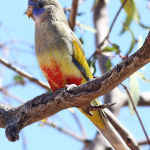Binomial Name:
Northiella Haematogaster
Info:
The bluebonnet parrot is a medium sized parrot with prominent crest-like head feathers. All bluebonnets have a mostly olive-grey to brown upperbody, foreneck and breast, with the outerwing and leading edge to the folded wing being dark blue, a blue forehead and face. The bill is pearl grey, the cere is light grey, iris colour is brown-grey, and the feet and legs are dark grey. There is no seasonal variation in the plumage and there are no similar looking species to the bluebonnet parrot.
Habitat & Food:
Bluebonnets inhabit arid and semi-arid zones in Australia. They inhabit open woodlands dominated by false sandalwood Myoporum, Belah Casuarina, native pine Callitris, Western Myall, Gidgee, and Mulga Acacia, and Eucalyptus, often with a low shrub layer of chenopods such as Saltbush Atriplex or Blue Bush Maireana. Bluebonnets will also inhabit open grassy plains, scrub, and trees bordering watercourses. Remnant patches of mallee in northern Victoria are also important habitat areas for birds in the south of their range.
Bluebonnets feed mostly on the ground on the seed of native and introduced grasses, herbaceous plants, trees and shrubs as well as foraging on fruit, berries, vegetable matter, flowers, nectar, insects and their larvae and in arid areas the seeds and fruit of the Saltbush.
All bluebonnets mainly drink at dawn and dusk and are cautious when approaching water.

